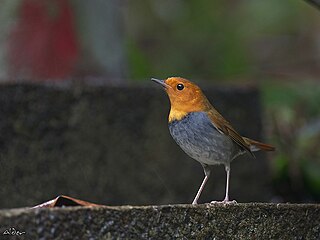
The Japanese robin is a small passerine bird in the family Muscicapidae. This species was formerly named Erithacus akahige, or Komadori. Its range extends from the south of the Kuril and Sakhalin Islands throughout Japan.

The Ryukyu robin is a bird endemic to the Ryūkyū Islands, of Japan. The Okinawa robin previously was considered a subspecies.
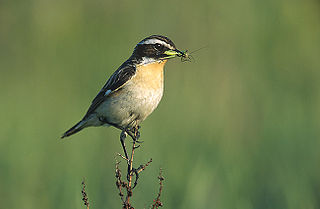
Chats are a group of small Old World insectivorous birds formerly classified as members of the thrush family (Turdidae), but following genetic DNA analysis, are now considered to belong to the Old World flycatcher family (Muscicapidae).

The Old World flycatchers are a large family, the Muscicapidae, of small passerine birds restricted to the Old World, with the exception of several vagrants and two species, bluethroat and northern wheatear, found also in North America. These are mainly small arboreal insectivores, many of which, as the name implies, take their prey on the wing. The family is relatively large and includes 351 species which are divided into 54 genera.

The blue rock thrush is a species of chat. This thrush-like Old World flycatcher was formerly placed in the family Turdidae. It breeds in southern Europe, northwest Africa, and from Central Asia to northern China and Malaysia. The blue rock thrush is the official national bird of Malta and was shown on the Lm 1 coins that were part of the country's former currency.

The Siberian blue robin is a small passerine bird that was formerly classified as a member of the thrush family, Turdidae, but is now more generally considered to belong to the Old World flycatcher family, Muscicapidae. It and similar small European species are often called chats. Recent research suggests that this species and some other East Asian members of Luscinia should be classified in a new genus, together with the Japanese and Ryūkyū robins. The genus name Larvivora comes from the Neo-Latin larva meaning caterpillar and -vorus meaning eating, and cyane is Latin for "dark-blue".

The Indian blue robin is a small bird found in the Indian Subcontinent. Formerly considered a thrush, it is now considered one of the Old World flycatchers in the family Muscicapidae. It was earlier also called the Indian blue chat. It is migratory, breeding in the forests along the Himalayas of Nepal, India, Myanmar and Bangladesh. They winter in the hill forests of the Western Ghats of India and in Sri Lanka.

The monarchs comprise a family of over 100 passerine birds which includes shrikebills, paradise flycatchers, and magpie-larks.
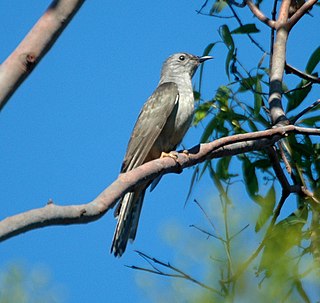
The brush cuckoo is a member of the cuckoo family.

The Nilgiri blue robin, also known as Nilgiri shortwing, white-bellied shortwing, Nilgiri sholakili or rufous-bellied shortwing is a species of passerine bird in the family Muscicapidae endemic to the Shola forests of the higher hills of southern India, mainly north of the Palghat Gap. This small bird is found on the forest floor and undergrowth of dense forest patches sheltered in the valleys of montane grassland, a restricted and threatened habitat.

The Javan blue robin is a species of bird in the family Muscicapidae. It is endemic to the Indonesian island of Java. Its natural habitat is subtropical or tropical moist montane forests. The Sumatran blue robin was formerly considered a subspecies of M. diana, with both the Javan and Sumatran subspecies being grouped under the name Sunda robin.

Cyornis is a genus of birds in the Old World flycatcher family Muscicapidae most of which are native to Southeast Asia.
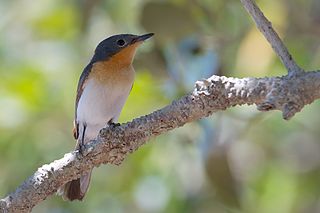
The broad-billed flycatcher is a species of bird in the family Monarchidae. It is found in northern Australia, the Lesser Sunda Islands and southern New Guinea. Its natural habitats are subtropical or tropical moist lowland forest, subtropical or tropical mangrove forest, and subtropical or tropical moist montane forest.
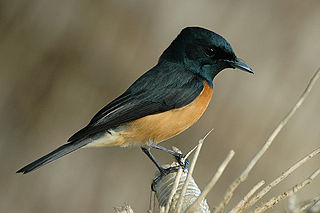
The Vanikoro flycatcher is a species of monarch flycatcher in the family Monarchidae. It has a slightly disjunct distribution, occurring on Vanikoro island and in Fiji.

Niltava is a genus of passerine birds in the Old World flycatcher family Muscicapidae. They are found in found in South and Southeast Asia as well as in China. The seven species in the genus are sexually dimorphic. The males have blue upperparts and all except the large niltava have orange-rufous underparts. The females are less brightly coloured and have brown upperparts and buffish underparts.

The Flores jungle flycatcher is a passerine bird in the Old World flycatcher family Muscicapidae that is endemic to the Lesser Sunda Islands.

The white-bellied blue robin or white-bellied sholakili, is a bird of the family Muscicapidae. It is endemic to the Shola forests of the higher hills of southern India. The Nilgiri blue robin and this species were once considered separate species, later lumped as sub-species of a single species (major) and elevated again to full species in 2005 by Pamela C. Rasmussen. The species was earlier thought to be related to the shortwings and placed in the genus Brachypteryx and later moved to Myiomela since species in the genus Brachypteryx shows marked sexual dimorphism. In 2017, a study found that this is a sister group of the flycatchers in the genera Niltava, Cyornis and Eumyias among others. It was then placed in newly erected genus Sholicola. This small bird is found on the forest floor and undergrowth of dense forest patches sheltered in the valleys of montane grassland, a restricted and threatened habitat.

Myiomela is a genus of bird in the family Muscicapidae. Some members have sometimes been included in the genus Cinclidium and the phylogeny has not been resolved completely.

















